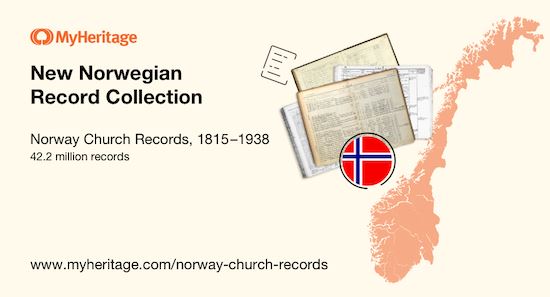
We are pleased to announce the addition of a new Norwegian historical record collection — Norway Church Records, 1815–1938. The records in this collection were digitized in collaboration with the National Archives of Norway (Arkivverket), and consist of 42.2 million indexed records and high quality scans of the original documents. The records include births & baptisms, marriages, and deaths & burials. This release is the first time the collection’s images are fully indexed and searchable — making it easier than ever to research your Norwegian ancestors. The addition doubles the number of Norwegian historical records on MyHeritage and brings the total number of historical records on MyHeritage to 12.6 billion.
Search Norway Church Records, 1815–1938
The years covered by the collection were significant in Norway’s history. In 1814, Norway seceded from Denmark, and with it, a new national identity began to emerge.
The Evangelical Lutheran Church has been the state church in Norway since 1536, and its pastors acted on behalf of the government to collect and preserve vital records. This important collection helps overcome the significant gaps in Norwegian censuses taken from 1801 to 1865. Though five censuses were collected in Norway during those years, they did not record names of individuals, making these church records the definitive source for genealogical data during this period.
Birth and Baptism (Fødte / Døpte) Records
By decree issued in June of 1814, children were to be baptized or have a confirmation of baptism at the parish church before the child was nine months old. However, it was customary for children to be baptized or “christened” within a few days or weeks of birth.
The records contain the birthdate and the baptism date, both parents’ names, marital status, place of residence, the child’s legitimate or illegitimate status, and the names of godparents and witnesses.
Due to Norwegian privacy laws, the birth & baptism records released in this collection extend until the year 1919 (inclusive).
Patronymic surnames were widely used in Norway until 1923. For example, children of a man with a first name of Erich would have the patronymic surname Erichsdatter (for his daughter) or Erichsen (for his son). In 1923, the Norwegian Names Act was passed which required each family to use a single, hereditary last name.
In the Norway Church birth and baptism records, a child was often recorded with only his or her given name(s) without an expressly recorded surname, as it was assumed the child would take either a patronymic surname from their father or take a hereditary surname.
To overcome the challenge of the missing surname, MyHeritage inferred two possible surname variations for each individual, so users can search for either the patronymic or hereditary surname to find the correct record. For example, if an infant was listed in the birth register as the son of Erich Berg, but without a surname, MyHeritage indexed the patronymic Erichsen and the surname Berg so this person can be found by searching either of them as the surname. For a daughter, the patronymic Erichsdatter would be indexed along with the surname, Berg. This is the way records were indexed by MyHeritage to make them discoverable, but the actual records were not modified, and the surnames were not inserted into them, to preserve their authenticity.
Marriage (Viede, Copulerede, Ægteviede) Records
Traditionally, marriages occurred in the bride’s home parish if the bride and groom were from different communities. Marriage records include the bride’s and groom’s names, birthplaces, marriage date, ages, and often their places of residence and occupation. Records also indicate whether the bride or groom were single or widowed before the marriage. After the 1830s the records frequently include the names of both the bride’s and groom’s fathers.
Due to Norwegian privacy laws, marriage records extend until 1937 (inclusive).
[clipped]
You can read the full article at: https://blog.myheritage.com/2020/10/myheritage-releases-major-collection-of-historical-norway-church-records-1815-1938/